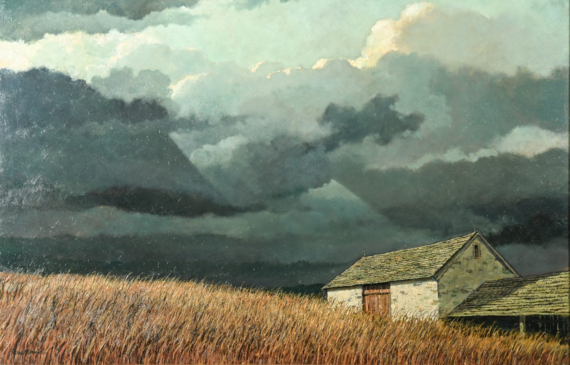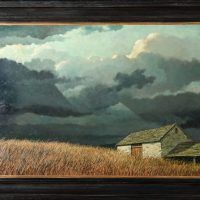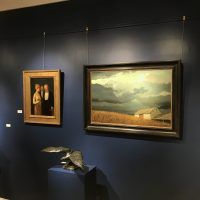


Eric Sloane
American, 1905–1985
Approaching Storm
Oil on masonite
24 H. x 36 W. inches
Exhibited:
Hammer Galleries, New York, Eric Sloane Memorial Exhibition, 1986. Illustrated cat. no. 25257-001, page 8.
Provenance:
The Artist
Hammer Galleries, New York, 1986
Private Collection, New York, NY
In the summer of 1925, Sloane “ran away from home” at 20, having squandered (he felt) his inheritance from his father. Working his way across the country as a sign painter, he created advertisements for everything from Red Man Tobacco to Bull Durham. Unique hand calligraphy and lettering became a characteristic of his illustrated books.
Sloane eventually returned to New York City and settled in the Merryall area of New Milford, Connecticut, where he began painting rustic landscapes in the tradition of the Hudson River School. In the 1950s, he began spending part of the year in Taos, New Mexico, where he painted western landscapes and particularly luminous depictions of the desert sky. In his career as a painter, he produced over 15,000 works. His fascination with the sky and weather led to commissions to paint works for the U.S. Air Force and the production of a number of illustrated works on meteorology and weather forecasting. Sloane is even credited with creating the first televised weather reporting network, by arranging for local farmers to call in reports to a New England broadcasting station.
Sloane also had a great interest in New England folk culture, Colonial daily life, and Americana. He wrote and illustrated scores of Colonial era books on tools, architecture, farming techniques, folklore, and rural wisdom. Every book included detailed illustrations, hand lettered titles, and his characteristic folksy wit and observations. He developed an impressive collection of historic tools which became the nucleus of the collection in the Sloane-Stanley Tool Museum in Kent, Connecticut.